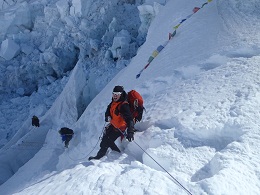From sick bed to the first rotation - 6752m
6/3/2022 10:52:14 AM

I had a cough, which was caused by inflammation, but now that situation has stabilized it was time to head towards camp 1. After forcing the breakfast down we took off towards the icefalls. Some 20 minutes later I had an odd feeling that made me wonder if I had all the necessities. I went through the list of necessities in my mind and uttered some not so nice words when I noticed that I had forgotten sunglasses. I went through the contents of my rucksack which confirmed my forgetfulness and meant hike back to Base camp. Short extra hike washed remaining feelings of sleepiness away and journey through the icefall went smoothly.
I stopped at a secure place for a cup of tea and weetabix, which have proved to be the safest source of energy from what is available for us. I felt good and soon after 9 am I was in C1 melting snow. Time went annoyingly slowly and for a moment we were thinking about continuing to C2. We naturally decided to stick to the agreed plan and continue journey with Mika, who was resting in BC and due to arrive C1 the following day. Matate, who took off at the same time from BC, arrived to the camp at noon. We had lunch and tried to kill time, mostly by resting. I had radio contact to Mika in the evening and we revised next morning’s schedule and program.
Mika and other members of our expedition arrived to C1 at 9 am we continued towards C2. Mika told that he had not slept well and had not had breakfast, which made him feel a bit shaky. We decided to continue journey at our own pace. We arrived to C2 (at 6500m) after a 2-hour trek, which meant long day without anything particular to do. However, we have learnt that one must not do much, but instead concentrate on resting. Even a few steps in high altitude makes heartbeat rise almost above anaerobic level and trekkers puff like steam trains.
The air pressure is half of that at the sea level, therefore, recovering from a strenuous physical exercise takes considerably more time. Air preasure is even more weaker in upper camps and changes to get a altitude sickness grow. Due to this, climbers do rotations between camps in order to get used to thin air and to get necessary rest.
Mika arrived to C2 three hours after me and told that he will rest the following day. We had not accepted some facts, which though we have acknowledged. It had been only 1 ½ days from Mika’s last rotation and there had not been enough time to recovering. Short, uneven sleep and non-existing appetite did not actually facilitate recovering. The reason for Mika’s short rest is that he wanted to reach C1 before the weather is forecasted to get worse.
On Saturday morning Indian Arjun and I ascended towards the beginning of Lhotse wall. We were thinking about ascending the wall for a while in order to get some experience of the frightening mass of blue ice, which ascends 1200 m to 8000 m varying from 40 to 60 degrees. However, we decided to give space to climbers, who aim at reaching camp 3, which lies in the middle of Lhotse at 7300m.
My neck was very stiff after the inflammation and the stiffness and pain made me sleep poorly. The return journey to the base camp from my part begun with very annoyed feelings. Mika was feeling energetic after one day rest and descended fast jumping over crevasses. We stopped in C1 to pick up our human waste bags and continued towards the icefall. I caught Mika and a sizable group of other climbers at icefall’s blue ice. We descended 10 m from the surface of the glacier into a crevasse and ascended along aluminium ladders back to the surface. First 2 climbers were tangled with their climbing gear to ropes and were not able to release themselves without help. Everyone, who understands physics of a glacier understands that we are on a very unstable and dangerous spot. As if it was a reminder from glacier, a car-sized serac fell crumbling into a crevasse, thankfully without harming anyone. Deep sounds and shaking mad us to move faster. Mika overtook other climbers by taking “outer curve” without pausing at the critical spot.
We discussed in the evening how easily expeditions take members to their groups. It feels as if groups rarely set any kind of skills criteria for member. Of course we cannot claim to be experienced climbers ourselves, but we have sufficient basic climbing skills and ability take care of ourselves in demanding circumstances.
Acclimatisation has gone well so far and we have been able to follow planned schedule. Later this week we continue acclimatization and take a couple-of-days climb to upper camps and take equipment to C3 where we rest and wait for suitable weather for summit push, which will probably take place during the second week of May.
Timo